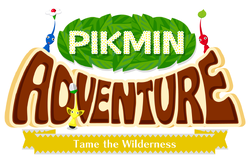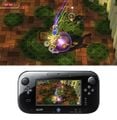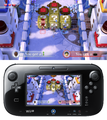Pikmin Adventure: Difference between revisions
(Cleanup.) |
mNo edit summary |
||
| Line 3: | Line 3: | ||
|name = Pikmin Adventure | |name = Pikmin Adventure | ||
|jpname = {{j|ピクミンアドベンチャー|Pikumin'adobenchā}} | |jpname = {{j|ピクミンアドベンチャー|Pikumin'adobenchā}} | ||
|image = | |image = Pikmin Adventure logo.png | ||
|ratings = E 10+ | |ratings = E 10+ | ||
|console = Wii U | |console = Wii U | ||
Revision as of 06:51, January 28, 2015
| Pikmin Adventure | |
|---|---|

| |
| Pikmin Adventure | |
| Console | Wii U |
| Developer | Nintendo |
| Publisher | Nintendo |
| Genre | Action Strategy |
| Players | {{{players}}} |
| Release date | |
| Japan | N/A |
| North America | N/A |
| Europe | N/A |
| Australia | N/A |
| South Korea | N/A |
Pikmin Adventure is a mini-game featured in the Wii U title Nintendo Land. As its name suggests, it is the Pikmin-themed mini-game of the 12 Nintendo franchise-based mini-games playable in Nintendo Land.
Unlike normal games in the Pikmin franchise, Pikmin Adventure is a fast-paced, action packed experience, as opposed to the real time strategy-styled puzzle solving nature of the other ones. Pikmin Adventure also includes a multiplayer versus mode.
Gameplay
Pikmin Adventure is played with one to five players. One player controls their Mii dressed in Olimar's spacesuit, and uses the Wii U GamePad, while up to four others use the Wii Remote to play as Miis dressed as assorted, larger Pikmin. Olimar also has a group of smaller Pikmin he controls, and are differentiated from the player-controlled Pikmin by their smaller size and resemblance to chess pieces. In addition, the player controlling Olimar has the option of using his whistle to call every Pikmin to his side (including those controlled by other players) using the icon on the lower left of the touch screen, or by pressing ![]() . Each player's health is represented by hearts on the HUD. If a player is turned into dung or damaged, they can be saved by another without a heart being consumed. There are two ways of playing: single player and multiplayer. In single player mode, the player uses their Olimar-dressed Mii and a randomly-assigned AI controlled Mii Pikmin to fight with.
. Each player's health is represented by hearts on the HUD. If a player is turned into dung or damaged, they can be saved by another without a heart being consumed. There are two ways of playing: single player and multiplayer. In single player mode, the player uses their Olimar-dressed Mii and a randomly-assigned AI controlled Mii Pikmin to fight with.
The gameplay happens in a style similar to the caves featured throughout Pikmin 2. The players must all get to the ship at the end of each course, while avoiding mechanized enemies based on those from the Pikmin franchise, such as Bulborbs. This also includes entirely-new creatures to the series, each of which with its own name, family classification, and biology notes, similar to the Piklopedia in Pikmin 2.
Players can occasionally find nectar inside defeated enemies or hidden within "?" blocks, which levels them up into bud and then flowers, increasing their speed and damage. The players must attack enemies on their weak spots (indicated as purple glass spheres) to inflict proper damage, similar to how fighting has become in Pikmin 3. To end the level, players must defeat that area's boss or enemy horde, and enter the ship to blast off to the next area. Certain levels also play out similar to Super Mario 3D Land, in which there is a time limit, and players must continuously kill enemies and overcome obstacles to gain more time, to keep the timer from reaching 0.
Controls
One player will play as Olimar on the GamePad. The touch screen is used to throw Pikmin, and ![]() is used as the whistle. The whistle will call every player and normal Pikmin to the GamePad user. In extra levels,
is used as the whistle. The whistle will call every player and normal Pikmin to the GamePad user. In extra levels, ![]() is used to change the type of Pikmin between blue, yellow, red, and mixed.
is used to change the type of Pikmin between blue, yellow, red, and mixed.
The Wii Remote players use ![]() to attack,
to attack, ![]() to jump, and
to jump, and ![]() to move around. All players can pick up boulders and bombs.
to move around. All players can pick up boulders and bombs.
Power ups
- Hammer Seed
- Whip seed
- Knuckle seed
- Bombs (one-time use)
- Rocks (one-time use)
Bosses and enemies
|
To do: Explain what the "other regions" are. |
Pikmin Adventure comes with its own set of enemies and bosses, all of which are a mechanical homage to the Pikmin universe. The most common family is the Beeb family, and in other regions, they are known as Baubs, and are part of the Soplouse family. Bosses use the Titan Dweevil's theme.
The following is a list of enemies in the game:
- Enemies
- Red Bulborb
- Yellow Bulborb
- Green Bulborb
- Bilious Bulborb
- Telescoping Pumphog
- Blowhog
- Creepy Beeb
- Bombardier Beeb
- Bosses
- King Beeb
- Bulblord
- Grand Bulblord
- Large-Mouth Wollywog
- Translucent Wollywog
- Emperor Pinchipede
- Monochromatic Pinchipede
- Bladed Beeb
- Greater Studded Beeb
Plants and objects
The following plants and objects exist:
- Abundant Mass
- Angular Sapling
- Bulbous Sporehaven
- Carved Pikmin
- Draft Jumper
- Fronded Stump
- Fungiform Family
- Glacial Fungicap
- Herbaceaous Kettle
- Hyperborean Verdant Silo
- Jumpswitch
- Sinuated Flora
- Spiral Timber
- Striped Conifer
- Vegetal Pouch
- Verdant Silo
- Verging Bloom
Gallery
|
To do: State which level that "snowy level" is. |
Trivia
- White Pikmin is the only type of Pikmin that a Wii Remote user can use that Olimar does not have. Purple Pikmin do not make an appearance in this attraction.
- If a Red Pikmin using the Wii Remote is thrown by Olimar, it will home in to the enemy's weak spot.
- If a player dies around 3 times, the game spawns the Assist Block, which will convert all players to Level 50. In timed challenges, it adds a minute to the clock.
- Pikmin Adventure has the most bosses of any attraction. Battle Quest has two and Metroid Blast has three, but this attraction has nine.
- Depending on the current location, a remixed theme of the Impact Site, Forest Navel, or Valley of Repose will play.
- The Wii Remote Pikmin have different colored shapes under them:
- Blue Pikmin have a blue circle.
- Red Pikmin have a red square.
- Yellow Pikmin have a yellow triangle.
- White Pikmin have a purple star.
- The Knuckle Seed correlates to Rock Pikmin, the Hammer Seed correlates to Purple Pikmin, and the Whip Seed correlates to the Winged Pikmin – the three main types of Pikmin that do not appear in this mini-game normally.
External links
|
This article is a stub. You can help Pikipedia by expanding it. |
| Games | |
|---|---|
| Main games | Pikmin • Pikmin 2 • Pikmin 3 • Pikmin 4 |
| Spin-off games | Hey! Pikmin • Pikmin Bloom |
| Re-releases | New Play Control! Pikmin • New Play Control! Pikmin 2 Pikmin 3 Deluxe • Pikmin 1 (Nintendo Switch) • Pikmin 2 (Nintendo Switch) |
| Web games | Pikmin.com SpaceForce • Pikmin Treasure Hunt • Pikmin Finder |
| Super Smash Bros. series | Brawl • for Nintendo 3DS and Wii U • Ultimate |
| Others | Pikmin Adventure (Nintendo Land) • Stage Debut |






